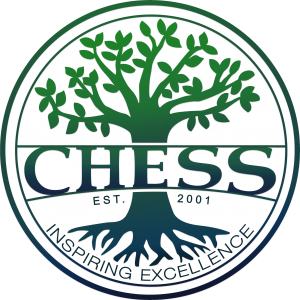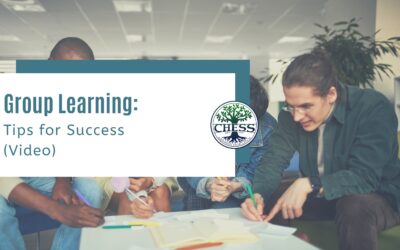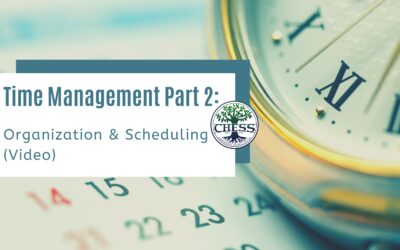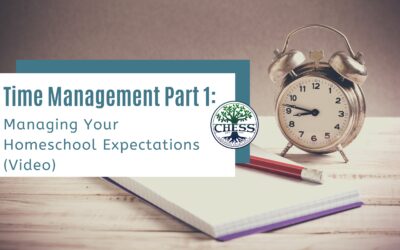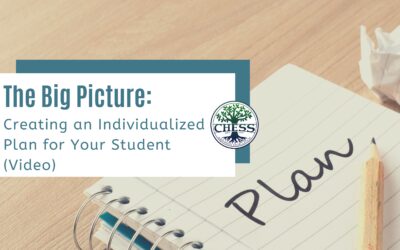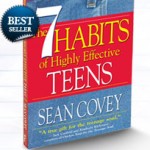Group Learning: Tips for Success
Time Management Part 2: Organization and Scheduling
Time Management Part 1: Managing Your Homeschool Expectations
The Big Picture: Creating an Individualized Plan for Your Student
Cornell Style Note-taking
Cornell Style Note-taking
Kimberly Glover, CHESS teacher and homeschool parent, shares about a helpful method of note taking that can be used in CHESS classes as well as at home.
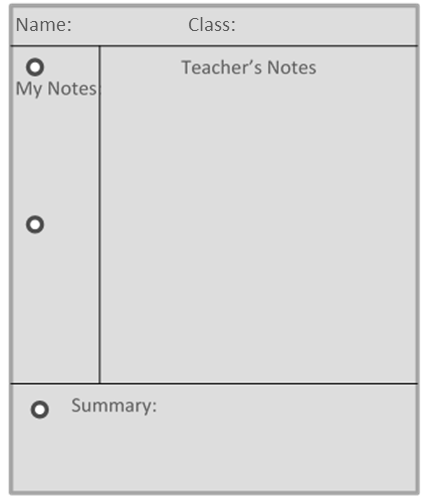
One of the most difficult things for me as a student was taking the information taught in class and understanding it well enough to keep the material in my storehouse of knowledge. Memorization was easy. I could repeat facts by writing them down on a test, but that didn’t always translate into knowing a subject well enough to carry it with me outside of the classroom. I believe a student can learn to do this by putting the information into his brain in a way he understands. This is where the “Cornell Style” of note-taking can help.
Before we talk about actual note-taking, make sure your student understands the importance of keeping an orderly notebook for every class. Having everything in its place goes a long way in helping your student, but it’s essential for the student who struggles with a learning disability like ADD, ADHD, or Dyslexia. If your student can’t put their history notes in a chronological order as they were taught because they stuffed them in their bag rather than putting them directly in a notebook, they will already be at a disadvantage.
Cornell Notes:
The “Teacher’s Notes” section of the page is simply the information the teacher gives in class. If a teacher writes it down on the board or shows any visual during class time, it will go in this section. This is the information explained by the teacher as she [the teacher] understands it. Typically what a teacher writes out will be the main ideas of the lesson, so “Teacher’s Notes” is essentially the big picture of what the teacher wants the student to understand.

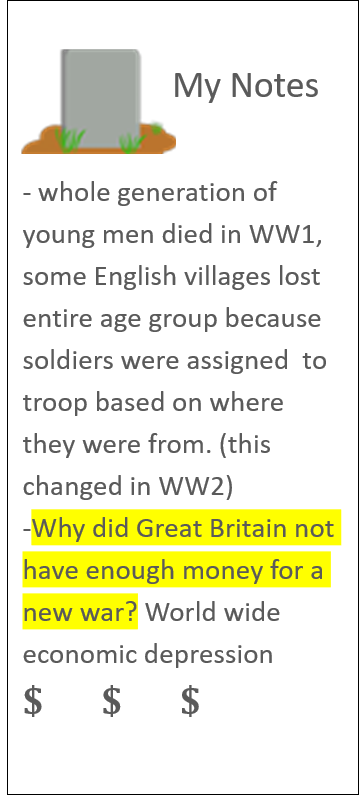
The “My Notes” section will have information that the student gleans from the teacher’s discussion of the topics. These notes will build on the ideas that the teacher has written on the board. This is the beginning of the student taking the teacher’s information and making it their own.
For myself, I am a visual learner. If you are giving me directions to your home, don’t tell me or write it out—instead, draw me a map. When I take notes (like in the “My Notes” section) there will be symbols and simple drawings along with my written notes to help focus my mind. This is also a good place to bring in colored pencils and highlighters. Sometimes a teacher will ask questions to make sure the students are grasping the material; the “My Notes” section is a good place to put these questions because typically if it’s asked in class it will be on an exam.
While the “Teacher’s Notes” and “My Notes” are both done in class, “Summary” is done at home, preferably the same day. The student will take everything from both sets of notes and combine them into a paragraph. This is basically the section where the student should be able to have a written conversation about what they learned on the subject and realize any gaps they may have (like definitions of words). If the topic is of interest to them this is a great place to add more information.

By taking notes using the “Cornell” model, your student should be able to look back over a semester’s (or longer) worth of work and easily prepare for an exam. If your student practices this method, (using it to take notes during sermons is great idea), by the time they get to college they will have an easier time keeping up with the higher level work. Amazon sells Cornell notebooks and Cornell notebook paper to make this process even easier for students or you can draw the lines yourself on regular notebook paper.
While I have discussed this topic as it pertains to students taking classes at CHESS, this is also a great method for homeschool students to use when they are studying a subject on their own or with a parent.
Kimberly combined her passions for teaching and photography into one fulfilled dream at CHESS. She has always loved teaching, beginning with the Bible classes she taught as a high school student. She studied English at the University of Memphis in Tennessee, with the goal of teaching high school, and also studied psychology at Northwestern State University in Louisiana.Married to a writer and editor, she has been educating their children at home for more than a decade. Mrs. Glover’s passion for photography inspired her decision to start Cedar Box Photography six years ago. She applies the creative skills she has learned in that role to her activities in the homeschooling community, which include yearbook photography, senior portraits and graduation photos.
The Importance Of Rest To Academic Success
 by Emily Hauge, former CHESS student and graduate of the College of William and Mary
by Emily Hauge, former CHESS student and graduate of the College of William and Mary
“If I go to bed right now and fall asleep in the next seven minutes I will get exactly six
hours of sleep.” Sound familiar? I know the science. I know that a lack of sleep
reduces my cognitive ability enormously, while simultaneously blurring my ability to
see the deficit. I’d venture to guess this isn’t news to you either. But why do we find it
so hard to prioritize something as basic as sleep?”
Seizing Control of Your Time
Classroom Courtesy Countdown!
Want to succeed in your academic and social graces this year? Read and apply the CHESS Classroom Courtesy Countdown! Special thanks to Kathy Kuhl for brainstorming this idea.
And now, the countdown…
10. Always label your work with your name in the format as requested by the teacher.
9. Write legibly.
8. If you are late for class, come in quietly.
7. Always ask permission from the teacher if you need to leave the room.
6. Raise your hand, then wait to see if you are called on before speaking.
5. Participate! You determine what you get out of the class.
4. Always ask the teacher when you don’t understand, someone else may not understand either.
3. Come prepared with your books, homework, writing tools, etc.
2. When you are absent, find out about your homework before the next class meets.
1. Always respect others, keep your hands, feet, or other personal items to yourself.
Dealing with procrastination
It’s silent and insidious. It frustrates our hopes and dreams. It tempts us to avoid the things we feel incompetent in doing, to put off the things we’re uncomfortable with, don’t like to do, or simply don’t care to do.
Its name: Procrastination.
In this past year, how many school- or life-changing inspirations have we received but failed to accomplish because we believed Procrastination’s lies?
Here are 7 actions that can help us defeat Procrastination:
1) Establish deadlines. Give yourself plenty of time to accomplish the work. A realistic deadline will inspire you to finish the task. After establishing this deadline, stick to it.
2) Be a finisher. Complete one simple task before starting another. Proofread the paragraph in the report before you go to lunch. Break big projects into smaller, manageable parts.
3) Build in a reward. Reward yourself when you finish a project or a portion of the project.
4) Be accountable. Have a parent or a study partner check on your progress when doing a long-term report or project. If they point out weakness in your progress, don’t begrudge them. Incorporate the good advice and push forward.
5) Say “NO” to less important duties. Focus on your goals and priorities and don’t let less important requests interrupt those key moments when you are about to finish a critical task.
6) Renew yourself. Maybe it’s time to pause and gather yourself for the last, big push. Play a computer game. Go for a walk. Get a snack. Refresh yourself and then go back to wrap up that critical task or project.
7) Eliminate perfectionism from your thoughts and vocabulary. Perfectionism is deadening. The trap of perfectionism will sap your energy, kill your creativity and encourage procrastination.
Bottom Line: Plan your work and work your plan. Establish realistic milestones with deadlines. Identify the parts of your assignment where you will be tempted to procrastinate. Start those difficult tasks when you are alert and have high energy. Build in rewards, encourage feedback from a parent, say no to less important tasks and toss perfectionism out the window! And if worse comes to worse, step away and renew yourself.
(reprinted and adapted with permission by Sue McMillin, With Time to Spare, www.withtimetospare.com)
~
About Sue. Sue McMillin is a professional organizer that John Jenkins, a teacher at CHESS, has worked for and with for over 20 years. As Sue’s website manager and editor, John has been privileged to read hundreds of articles and posts that she has written, as well as work with her in hands-on training of homeowners and business professionals around the country.
Sue has been published in Focus on the Family and various magazines and has written two books, one for organizing the home and one for the office. She is thoroughly biblical and committed to changing and improving lives and to make life easier.
7 Habits of Highly Effective Teens
Sean Covey’s book is a tremendous resource for accelerating learning and key life skills in your teen.
CHESS is delighted to share a one-page summary of these 7 Habits with you: 7 Habits of Highly Effective Teens.
Also, when you open the PDF, you will also find a link to the book’s companion website.
